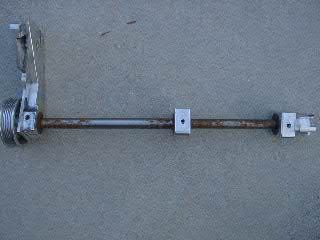Unfortunately the above assembly CANNOT be reassembled and installed back in the car as is. The drive unit MUST be returned to Mark Basch to be placed in a bearing alignment jig. The tolerances on these units is critical to keep the bearings intact. Please use caution and only remove the drive unit as an assembly.
and
I also remember Mark B. Specifically telling me not to remove the bearing carriers and shaft from the aluminum assembly. Larry is correct in telling you that the pieces will have to be put together using Mark’s jig to ensure proper shaft and bearing alignment.
and
The jig for reassembly is an alignment jig. It positions the bearing blocks exactly aligned.
and
Sorry to be late with this, but it would have been feasible to remove two bolts per bearing block, at one time, not upset the bearing position, then do the other two later. At this point, once you get the bolts back, pack them up with the entire assembly and get it to MB.
and
I still do not quite understand the problem of remounting the bearing / shaft assembly to the aluminum housing without Mark's jig. The variable bearing housing is the middle one; the ends are relatively fixed. Why would these simply not align with the housing mounting holes? I could understand that this would be a problem if I had removed the pulley / plate or the SC key, but it remains as a single unit and only the aluminum housing that mounts to the bearings has been removed.
Not picking an argument here, but unless there is some detail we don’t know, as long as the position of the bearing carriers on the shaft has not moved, there is no engineering reason (in my mind, anyhow) why simply bolting the bearing blocks back into the carrier will not work.
When I had the transmission rebuilt a few months ago, during on of my shop visits, I was looking over the Basch carrier. There are no shims between the bearing blocks and the long carrier. Therefore, lateral misalignment is not a problem. Unless!! Unless the long carrier itself is bent. This will cause the shaft to flex with each revolution. The minute flex is perhaps not enough to overstress the Thomson shaft; however, I can see that it could result in premature bearing wear. I think I am in agreement with StGeorge.....if the bearing blocks are simply unbolted and removed from the long carrier, as long as the bearings don’t move on the shaft, then simply bolting the bearing blocks back into long carrier should work. During original assembly of a drive unit when the bearings are pressed onto the shaft, it is critical of their axial position to line up with the bolt holes in the long carrier.
Here is a crude analogy from American Iron rear-end drive cars. Pressing the bearing onto the axle is a careful process. However, once the bearing position is established you can remove and reinstall the axle from the rear-end as many times as you want without needing a jig.
These bolts were almost immediately identified as quick to rust, and there is no reason to believe that the threaded portion was any less so than the tops.
You must’ve read my mind. I went home for lunch and for shits-n-giggles I removed one of the bolts. Although there is mild surface oxidation on the head, the threads look brand new perfect. So as a friendly rebuttal, not all threads of these bolts rust. I am not defending material selection, I am only saying that if fasteners were overtightened and / or no anti-seize paste was applied to the threads, then what is the true root cause of the bolt problems, material selection or the person tightening the bolts? In fact, material selection goes right out the window if a part is installed incorrectly. BTW, I do plan to replace the hex bolts with stainless steel versions, but that project is a very low priority on my list.
There's just no excuse for this to happen so quickly.
It doesn’t matter if the bolts rust within a month or two years.....bare carbon steel oxidizes. MB has nothing to do with Mother Nature’s chemistry of oxidation. On the other hand, if the argument is that the BBSC kit should come with chromed or stainless steel bolts, then I agree with that from an aesthetics viewpoint. Regardless what the bolts are made of, they should be pasted with anti-seize and not overtightened.





